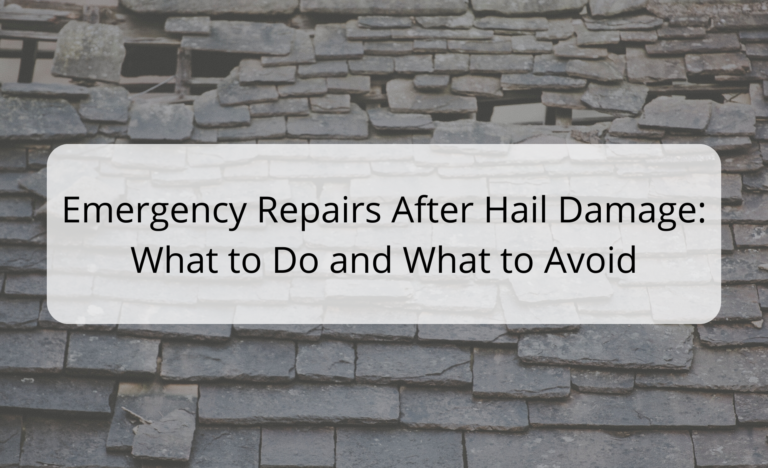Hailstorms can be relentless, inflicting significant damage on your property in just a matter of minutes. As the skies clear and the hailstones subside, the true extent of the destruction may come to light, leaving you to face the daunting task of repairing and restoring your home or business. While the immediate aftermath can be overwhelming, knowing how to handle emergency repairs after hail damage can make all the difference in protecting your property and securing your peace of mind.
At D.A. Lamont Public Adjusters, we recognize the emotional toll that hail damage can take and the importance of prompt action to mitigate further harm. In this blog, we are here to offer guidance on the essential steps to take and what to avoid when faced with hailstorm damage. Our mission is to support you through this challenging time, ensuring your property is safeguarded while you navigate the insurance claims process with confidence.
The Impact of Hail Damage
Hailstorms can unleash various forms of damage, leaving their mark on both residential and commercial properties. Some common types of hail damage include dented or cracked roofs, shattered windows, damaged siding, and compromised gutters. The impact of hailstones can also result in granule loss on asphalt shingles, exposing them to further deterioration over time. In severe cases, large hailstones can puncture or penetrate roofing materials, leading to leaks and water intrusion inside the property. Additionally, hail can harm outdoor structures, vehicles, and landscaping, making it crucial to conduct a comprehensive inspection of your entire property after a storm. Recognizing the various types of hail damage is essential when documenting your insurance claim and planning for emergency repairs to protect your investment.
Emergency Repairs After Hail Damage: A Step-by-Step Guide
In the aftermath of a hailstorm, dealing with property damage can be overwhelming. To help you navigate this challenging situation with confidence, we have prepared a step-by-step guide on what to do and what to avoid when addressing hail damage emergency repairs. Safety should be your top priority, followed by careful documentation of the damage. From addressing immediate roof issues to securing broken windows, this guide will walk you through the essential measures to protect your property and prepare for the insurance claims process. Remember, seeking professional help and guidance from D.A. Lamont Public Adjusters can streamline the claims process and ensure a fair settlement. Let’s get started on the path to recovery after hail damage strikes.
-
Prioritize Safety:
As hailstorms can be accompanied by intense winds and flying debris, your first and foremost concern should always be safety. Take immediate measures to ensure the well-being of yourself and your loved ones. Stay indoors and away from windows, seeking shelter in the most secure area of your property. If anyone sustains injuries during the storm, seek medical attention promptly. Only venture outside when local authorities declare the area safe, as additional hazards may still be present. Protecting human life takes precedence over all else, and being cautious can prevent further injuries and damage.
-
Document the Hail Damage:
As soon as it is safe to do so, document the hail damage to your property. Use your smartphone or camera to capture clear photographs and videos of the affected areas from various angles. Be thorough in your documentation, covering both interior and exterior damage. This visual evidence will be crucial when filing your insurance claim and negotiating a fair settlement.
-
Address Immediate Roof Damage:
The roof is one of the most vulnerable areas during a hailstorm. Inspect your roof for any visible damage, such as dented or missing shingles, cracks, or punctures. If there are leaks or visible damage, make temporary repairs to prevent further water intrusion. Cover any openings with tarps or boards until a professional roofer can assess the extent of the damage.
-
Secure Broken Windows and Openings:
Hail can cause windows to shatter, leaving your property vulnerable to weather elements and potential break-ins. Safeguard your home or business by boarding up or covering broken windows and openings. Secure any compromised entry points to prevent unauthorized access and further damage.
-
Clear Debris and Fallen Trees:
After a severe hailstorm, your property may be littered with debris and fallen trees. Safely remove any debris and fallen branches to prevent tripping hazards and further damage. If there are large fallen trees or branches that pose a safety risk, contact a professional tree removal service to handle the situation safely.
-
Tarping and Temporary Patching:
Tarping is an essential emergency repair for roofs that have sustained hail damage. Covering damaged areas with tarps helps prevent water from seeping into your property and causing additional harm. Additionally, consider temporary patching for areas where hail has caused leaks or damage. While these are temporary solutions, they can help protect your property until comprehensive repairs can be made.
-
Avoid DIY Repairs Beyond Temporary Measures:
While it is crucial to make temporary repairs to safeguard your property, avoid undertaking extensive DIY repairs beyond the immediate emergency measures. Hail damage can be more extensive than what is visible to the untrained eye. Attempting complex repairs without professional expertise may result in further damage or voiding your insurance coverage. Always seek the assistance of qualified contractors and restoration specialists to assess and repair hail damage.
-
Resist Immediate Full-Scale Repairs:
In the aftermath of a hailstorm, it may be tempting to begin full-scale repairs immediately. However, exercising patience is essential. Wait until your insurance claim has been assessed and processed by your provider and a public adjuster, if applicable. Rushing into repairs without a thorough assessment could complicate your claim and hinder the reimbursement process.
-
Document All Emergency Repairs:
Keep detailed records of all emergency repairs you make after the hailstorm. Save receipts, invoices, and any communication with contractors or service providers. These documents will serve as critical evidence when filing your insurance claim and will help ensure you receive fair compensation for your emergency repair expenses.
-
Seek Professional Help and Guidance:
Navigating the complexities of hail damage insurance claims can be overwhelming, especially while dealing with emergency repairs. Enlisting the assistance of a caring and experienced public adjuster like D.A. Lamont Public Adjusters can provide you with invaluable support. Our team will assess the full extent of the hail damage, document all damages accurately, and advocate on your behalf to maximize your insurance claim settlement.
Safeguarding Your Property and Peace of Mind
Handling emergency repairs after hail damage requires a delicate balance of prioritizing safety, preventing further damage, and preparing for your insurance claim. At D.A. Lamont Public Adjusters, we are committed to helping you navigate through this challenging time with compassion and expertise. Remember to prioritize personal safety, document all damages, make necessary temporary repairs, and resist immediate full-scale repairs until your insurance claim has been evaluated.
Our team is here to provide caring and compassionate guidance throughout the entire process. With our expertise, you can feel confident that your property is protected, and your insurance claim is handled efficiently. Let us help you restore and rebuild after hail damage, so you can move forward with peace of mind and a sense of security for your future.


